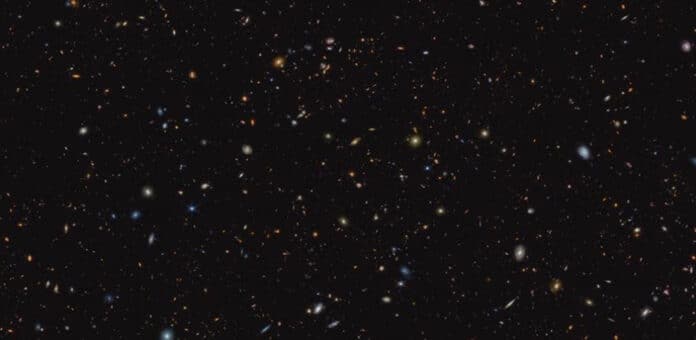How did the first stars and galaxies form?
Since its launch, NASA‘s Webb is already providing new insights into this question. One of its largest programs- JWST Advanced Deep Extragalactic Survey, or JADES- had already discovered hundreds of galaxies that existed when the universe was less than 600 million years old.
The international team, which includes Cambridge University researchers, has also discovered galaxies glistening with many hot, newborn stars.
The universe was enveloped in a gaseous fog for hundreds of millions of years following the Big Bang. The universe had become translucent, and the fog had lifted one billion years after the Big Bang, a process known as reionization. Scientists have argued which factor—active, supermassive black holes or galaxies bursting with hot, new stars—was primarily responsible for reionization.
As part of the JADES program, researchers studied these galaxies to look for signatures of star formation – and found them in abundance.
Ryan Endsley from the University of Texas at Austin said, “Almost every galaxy that we are finding shows these unusually strong emission line signatures indicating intense recent star formation. These early galaxies were very good at creating hot, massive stars.”
These big, bright stars emitted ultraviolet light, which ionized the atoms in the surrounding gas and stripped the electrons from their nuclei, turning the opaque gas transparent. These early galaxies may have been the primary cause of reionization because of their abundance of hot, massive stars. The later reunification of the electrons and nuclei produces distinctly strong emission lines.
The researchers also discovered proof that these young galaxies experienced periods of active star creation interspersed with quieter times when fewer stars emerged. It’s possible that these fits and starts happened as galaxies gathered clusters of the gaseous building blocks for stars. Alternatively, because large stars swiftly burst, they may have periodically infused energy into the atmosphere, preventing gas from expanding.
Another JADES finding made public today relates to how galaxies evolve structurally. An essential question in extragalactic astronomy, namely how the structural diversity of galaxies we view now came to be, was addressed by scientists using imaging and spectroscopy data.
Just 700 million years after the Big Bang, scientists found a galaxy in the early cosmos that had the structure of a much more mature galaxy. Despite being a hundred times less massive than the Milky Way, the galaxy is compact. This galaxy is expanding from the inside out, as evidenced by the fact that most of its newborn stars are located on its periphery.
The hunt for the oldest galaxies, which existed when the universe was younger than 400 million years old, is another component of the JADES initiative. Astronomers can learn more about how star formation differed in the early universe from what is observed today by examining these galaxies.
The hunt for the oldest galaxies, which existed when the universe was younger than 400 million years old, is another component of the JADES initiative. Astronomers can learn more about how star formation differed in the early universe from what is observed today by examining these galaxies.
The universe is expanding, causing the light from distant galaxies to be stretched to longer wavelengths and redder colors—a process known as redshift. Astronomers can determine a galaxy’s distance and, consequently, its age in the early universe by measuring its redshift. When the universe was less than 650 million years old, only a few dozen galaxies were observed above a redshift of 8. Still, JADES has already found roughly a thousand of these incredibly far-off galaxies.
Kevin Hainline of the University of Arizona in Tucson said, “Previously, the earliest galaxies we could see just looked like little smudges. And yet those smudges represent millions or billions of stars at the universe’s beginning. Now, we can see that some of them are extended objects with visible structures. We can see groupings of stars born only a few hundred million years after the beginning of time.”
